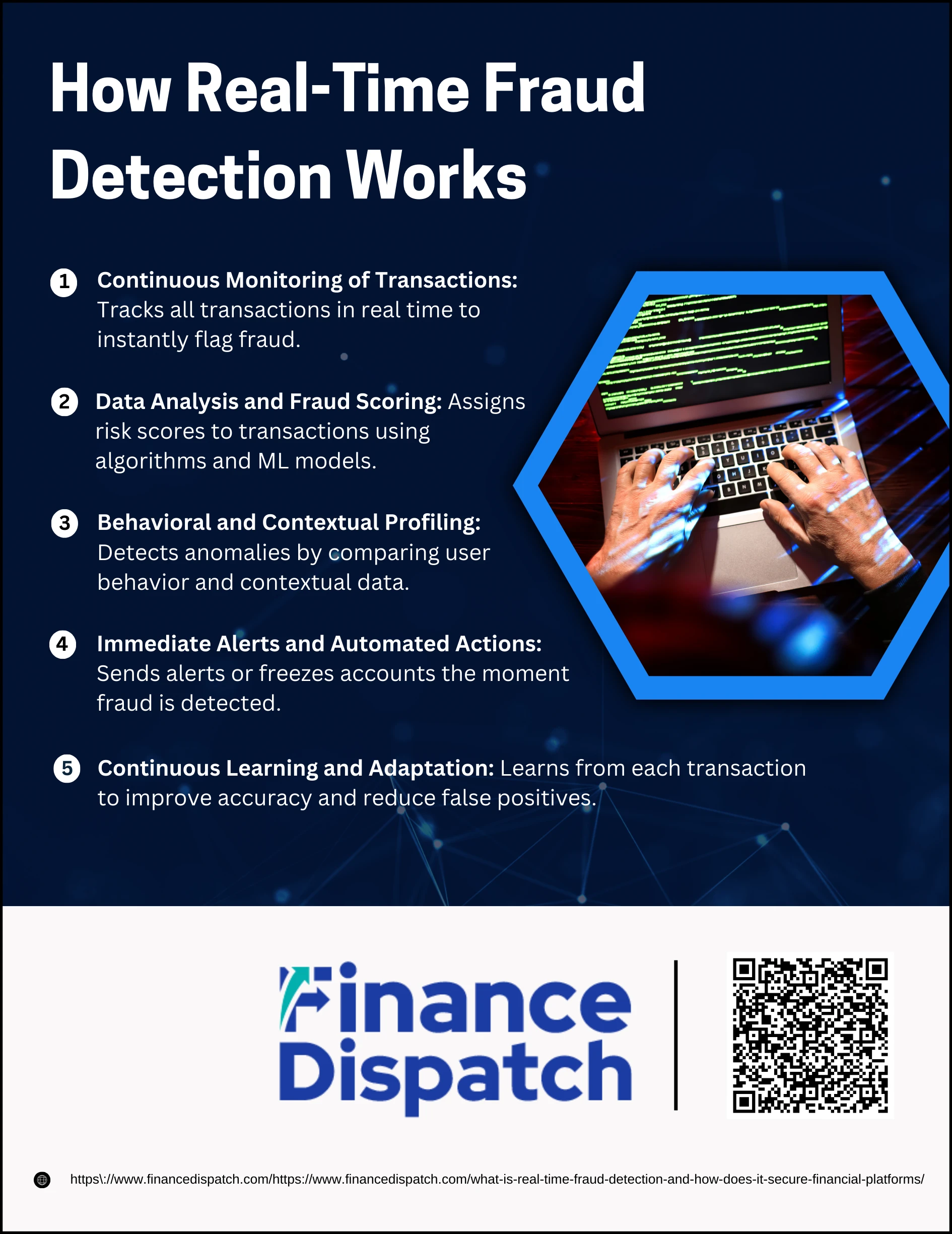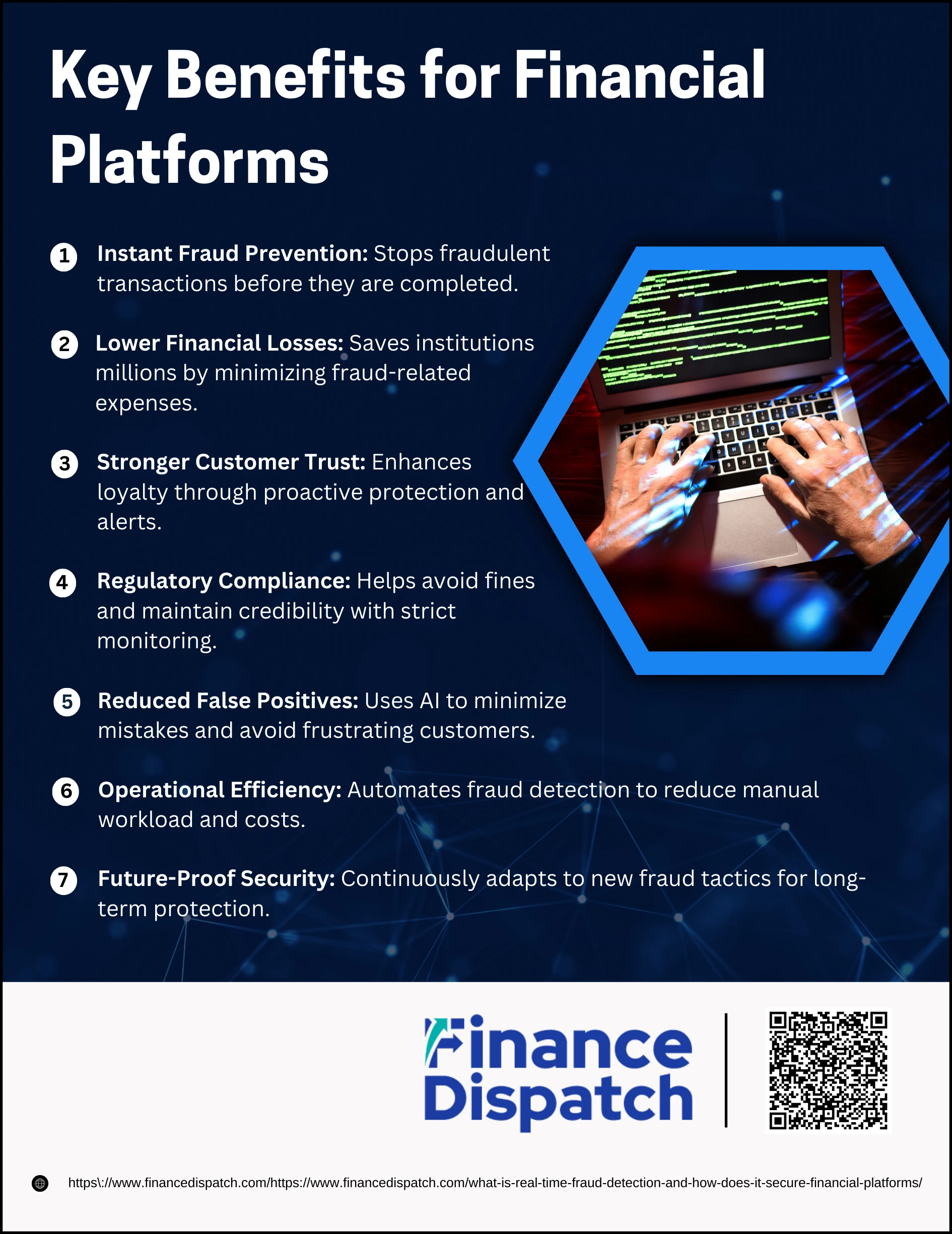In today’s digital-first world, financial platforms process billions of transactions every day—ranging from online shopping payments to high-value banking transfers. While this speed and convenience benefit customers, they also create opportunities for fraudsters who can exploit vulnerabilities within seconds. Traditional fraud detection methods, which often analyze transactions hours or days later, leave institutions exposed to heavy losses and reputational damage. This is where real-time fraud detection steps in. By monitoring transactions instantly, leveraging advanced algorithms, and flagging anomalies the moment they occur, real-time systems empower financial platforms to stop fraudulent activity before it causes harm. More than just a technological upgrade, this proactive approach has become essential for safeguarding assets, complying with regulations, and maintaining customer trust in an increasingly risky digital economy.
What is Real-Time Fraud Detection?
Real-time fraud detection is the process of identifying and stopping fraudulent activities the moment they occur. Unlike traditional systems that review transactions in batches after the fact, real-time detection continuously monitors every transaction as it flows through a financial platform. It relies on advanced algorithms, artificial intelligence, and behavioral analytics to flag unusual patterns—such as sudden large withdrawals, rapid-fire purchases, or logins from unfamiliar locations—within seconds. This proactive approach allows financial institutions and digital businesses to block suspicious activity instantly, protecting both customers and their own assets before damage is done.
 Why Financial Platforms Need Real-Time Fraud Detection
Why Financial Platforms Need Real-Time Fraud Detection
In today’s fast-moving digital economy, financial platforms process millions of transactions every second—from banking apps to e-commerce payments. This speed benefits customers, but it also opens the door for fraudsters who act within seconds. Traditional fraud detection methods often analyze transactions hours or days later, which means by the time fraud is identified, the damage is already done. Real-time fraud detection changes the game by spotting and blocking suspicious activity instantly. Here’s why it has become essential for financial platforms.
1. Instant Threat Response
Fraud happens in real-time, and the only way to combat it is with an equally fast defense. Real-time fraud detection systems continuously monitor every transaction and use algorithms to flag suspicious patterns within milliseconds. For example, if a stolen credit card is used for back-to-back high-value purchases, the system can freeze the account immediately. This quick intervention prevents fraud from escalating, protecting both the institution and the customer from significant losses.
2. Reduced Financial Losses
Every fraudulent transaction carries a direct financial cost, not just in lost funds but also in chargebacks, recovery efforts, and legal fees. By identifying fraud at the moment it occurs, financial platforms can stop unauthorized transactions before money leaves the system. This proactive approach significantly reduces losses and avoids the ripple effect of fraud-related expenses. Over time, the savings from real-time prevention outweigh the costs of deploying advanced fraud detection technologies.
3. Enhanced Customer Trust
Trust is the foundation of every financial relationship. Customers want to feel confident that their money and data are secure. Real-time fraud detection builds this confidence by ensuring that suspicious activities are blocked before they cause harm. For instance, when customers receive instant alerts about unusual account activity, they know their platform is actively protecting them. This proactive security not only boosts customer satisfaction but also strengthens loyalty in an increasingly competitive financial marketplace.
4. Regulatory Compliance
Financial platforms are under strict obligations to meet anti-fraud and anti-money laundering (AML) requirements, along with Know Your Customer (KYC) standards. Regulators expect institutions to demonstrate that they can detect and prevent fraud effectively. Real-time fraud detection helps meet these compliance requirements by providing continuous monitoring, accurate reporting, and audit trails. This reduces the risk of costly fines, legal penalties, and reputational damage that come with regulatory breaches.
5. Adaptability to Evolving Threats
Fraudsters constantly evolve their tactics, using new technologies like deepfakes, synthetic identities, and bot-driven attacks. Static, rules-based fraud systems quickly become outdated. Real-time fraud detection, however, leverages artificial intelligence and machine learning to adapt to new fraud patterns as they emerge. These systems learn from every transaction—both legitimate and fraudulent—so they become smarter and more accurate over time. This adaptability ensures that financial platforms stay one step ahead of criminals in an ongoing battle.
 How Real-Time Fraud Detection Works
How Real-Time Fraud Detection Works
Fraud moves at the speed of digital transactions. A stolen card can be used for back-to-back purchases within seconds, and a compromised account might be drained before the owner even notices. Traditional fraud detection, which often works in batches, simply reacts too slowly. Real-time fraud detection solves this problem by monitoring, analyzing, and acting on suspicious activity the moment it occurs. Here’s a breakdown of how the process works.
The Core Steps of Real-Time Fraud Detection
1. Continuous Monitoring of Transactions
Financial platforms track every transaction in real time, whether it’s a credit card swipe, an online purchase, or a transfer between accounts. This constant vigilance ensures fraudulent activity is flagged instantly rather than hours later.
2. Data Analysis and Fraud Scoring
Each transaction is run through a set of algorithms and machine learning models that assign it a fraud score. For example, if a transaction is unusually large or comes from a high-risk location, the score rises. Higher scores indicate greater suspicion and may trigger further checks.
3. Behavioral and Contextual Profiling
Beyond numbers, real-time fraud detection looks at user behavior. If a customer normally shops locally but suddenly makes multiple purchases overseas, the system recognizes the anomaly. Context like device type, IP address, and time of day all help create a full picture of risk.
4. Immediate Alerts and Automated Actions
Once something suspicious is detected, the system reacts immediately. This could mean sending an alert to the fraud team, holding the transaction for review, requiring extra authentication from the customer, or even freezing the account temporarily to prevent losses.
5. Continuous Learning and Adaptation
Fraudsters constantly change tactics. That’s why modern systems use machine learning to learn from every transaction—legitimate or fraudulent. Over time, the system becomes more accurate, reducing false positives and catching emerging fraud schemes faster.
Core Technologies Behind Real-Time Fraud Detection
Fraudsters are becoming smarter, faster, and more sophisticated—making it nearly impossible for traditional fraud detection systems to keep up. Financial platforms now rely on advanced technologies that work in real time to analyze vast streams of data, detect unusual activity, and block suspicious transactions instantly. These technologies form the backbone of modern fraud detection, ensuring security without slowing down customer experiences.
Key Technologies Powering Real-Time Fraud Detection
1. Machine Learning Algorithms
Continuously learn from historical and live data, spotting patterns and anomalies that could signal fraud. They adapt as criminals change their tactics, making detection smarter over time.
2. Artificial Intelligence (AI)
Automates decision-making at lightning speed, reducing the need for manual checks. AI systems can process thousands of transactions per second and trigger instant responses.
3. Big Data Analytics
Handles massive transaction volumes in milliseconds, correlating data from multiple sources such as devices, geolocation, and customer history to identify potential threats.
4. Behavioral Analytics
Profiles normal user behavior—like spending habits, login times, and preferred devices—and flags unusual deviations that may indicate fraud attempts.
5. Complex Event Processing (CEP)
Connects seemingly unrelated events, such as multiple rapid purchases or “impossible travel” between distant locations, to detect suspicious activity patterns.
6. Risk Scoring Engines
Assigns a risk score to each transaction, balancing speed with accuracy. Transactions with higher scores are flagged for review, while low-risk ones proceed seamlessly.
7. Device Fingerprinting & Biometrics
Identifies devices or users based on unique digital or biological traits, making it harder for fraudsters to impersonate legitimate customers.
 Key Benefits for Financial Platforms
Key Benefits for Financial Platforms
Financial platforms process millions of transactions daily, making them prime targets for fraudsters. Real-time fraud detection not only protects against losses but also improves trust, efficiency, and compliance. Here’s a deeper look at why it has become an indispensable tool.
1. Instant Fraud Prevention
Fraudsters operate in seconds, so prevention must be equally fast. Real-time systems continuously monitor transactions and flag suspicious ones before they’re completed. For example, if a stolen credit card is used for multiple large purchases in a short period, the system can block it immediately. This proactive approach prevents harm rather than reacting after losses have occurred.
2. Lower Financial Losses
Every fraudulent transaction comes with costs—direct losses, chargebacks, legal disputes, and recovery efforts. By detecting fraud instantly, financial platforms minimize these expenses. Stopping even a fraction of fraudulent activity can save millions annually, freeing resources that can be invested in growth and innovation.
3. Stronger Customer Trust
Customers expect their money and data to be safe. When platforms demonstrate that they can detect fraud instantly—such as sending alerts about unusual account activity—trust grows. This confidence encourages customers to stay loyal, use the platform more frequently, and recommend it to others, boosting long-term retention.
4. Regulatory Compliance
Regulators demand strict adherence to anti-fraud and anti-money laundering (AML) requirements, as well as Know Your Customer (KYC) standards. Real-time detection helps platforms meet these obligations by generating accurate reports, maintaining audit trails, and ensuring suspicious activities are flagged immediately. Compliance not only avoids fines but also strengthens credibility in the industry.
5. Reduced False Positives
Traditional fraud systems often inconvenience customers by wrongly flagging legitimate transactions. Modern real-time detection uses AI and machine learning to reduce these false alarms. By understanding customer behavior patterns, the system can distinguish between unusual but legitimate purchases and genuine fraud attempts, improving the user experience.
6. Operational Efficiency
Manual fraud reviews consume time and resources. Automated real-time systems cut down on unnecessary investigations by prioritizing only high-risk cases. This allows fraud teams to focus on complex scenarios instead of routine checks, reducing costs and making fraud management more efficient.
7. Future-Proof Security
Fraud tactics evolve constantly—whether it’s synthetic identities, deepfakes, or sophisticated phishing schemes. Real-time fraud detection adapts by learning from new data, continuously improving accuracy. This ensures platforms remain resilient against emerging threats and can maintain strong defenses well into the future.
Challenges and Limitations of Fraud Detection
While fraud detection systems have become more advanced with the use of AI, machine learning, and real-time monitoring, they are not without challenges. Financial platforms must balance speed, accuracy, customer experience, and compliance while managing vast amounts of data. Understanding these challenges is key to building stronger, more effective systems.
Key Challenges and Limitations
1. High Volume of Data
Financial institutions process millions of transactions per second, making real-time monitoring computationally demanding and resource-intensive.
2. Balancing Speed and Accuracy
Detecting fraud instantly is crucial, but systems must also avoid errors. Too much focus on speed can lead to mistakes, while excessive scrutiny can slow down transactions.
3. False Positives
Legitimate transactions are sometimes flagged as fraudulent, frustrating customers and increasing operational costs due to unnecessary manual reviews.
4. Evolving Fraud Tactics
Fraudsters constantly adapt with new methods like deepfakes, synthetic identities, and bot-driven attacks, challenging systems to stay ahead.
5. Integration with Legacy Systems
Many financial institutions still rely on outdated infrastructures, making it difficult to seamlessly integrate modern fraud detection solutions.
6. Cost of Implementation
Deploying advanced AI-powered fraud detection requires substantial investment in technology, skilled staff, and continuous updates.
7. Privacy and Compliance Concerns
Collecting and analyzing vast customer data raises regulatory and ethical challenges, especially with laws like GDPR and CCPA.
8. User Experience Impact
Extra verification steps, while necessary for security, can inconvenience legitimate users and affect customer satisfaction.
Real-Life Applications and Examples
Real-time fraud detection is not just a concept—it’s actively protecting businesses and consumers across multiple industries. By analyzing transactions and behaviors instantly, these systems prevent financial losses, maintain trust, and ensure smooth operations. Here are some practical applications and examples of how real-time fraud detection works in the real world:
Real-Life Applications
1. Banking Transactions
Detects suspicious withdrawals, unusual spending patterns, or rapid transfers, preventing credit card fraud and account takeovers.
2. E-Commerce Platforms
Flags fraudulent purchases, fake orders, and chargeback attempts, protecting revenue and reducing losses during high-volume sales periods.
3. Online Marketplaces
Identifies fake listings, fraudulent reviews, and seller scams, ensuring marketplace integrity and customer trust.
4. Digital Services and Software
Prevents unauthorized access, license misuse, and data breaches by monitoring login behavior and device activity in real time.
5. Telecommunications
Detects SIM card cloning, fake account registrations, and unusual call/data patterns to stop service abuse.
6. Healthcare and Insurance
Flags suspicious insurance claims, overbilling, or duplicate entries, helping providers prevent costly fraud.
7. Online Gaming and Gambling
Monitors irregular betting patterns, fake accounts, or stolen payment methods to ensure fair play and platform safety.
The Future of Real-Time Fraud Detection
The future of real-time fraud detection lies in smarter, faster, and more adaptive technologies. With advancements in artificial intelligence, machine learning, and predictive analytics, financial platforms will not only react to fraud but anticipate it before it happens. Blockchain technology promises added transparency and security, while biometric authentication and behavioral analytics will strengthen identity verification without adding friction for users. As fraudsters adopt new tactics such as deepfakes, synthetic identities, and AI-driven scams, detection systems will evolve into proactive, self-learning defenses. Ultimately, the future points toward a seamless balance of stronger security and smoother customer experiences, ensuring that fraud prevention becomes an invisible but powerful shield in the digital economy.
Conclusion
Real-time fraud detection has become more than just a security tool—it is now a core necessity for financial platforms in a digital-first world. By monitoring transactions instantly, analyzing vast streams of data, and adapting to evolving fraud tactics, these systems protect businesses and customers from costly losses and reputational harm. Beyond preventing crime, they also build trust, ensure regulatory compliance, and support long-term growth. As technology continues to advance, financial platforms that embrace real-time fraud detection will not only safeguard their assets but also gain a competitive edge by delivering both security and seamless customer experiences.



